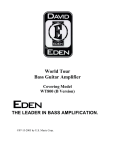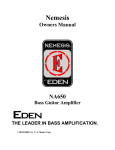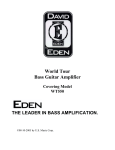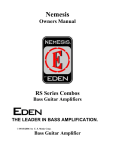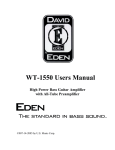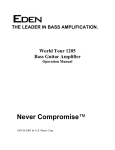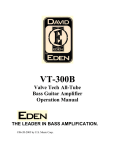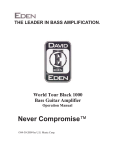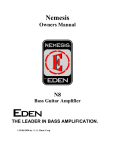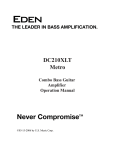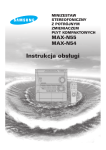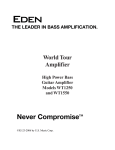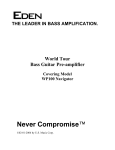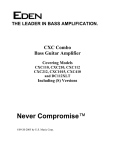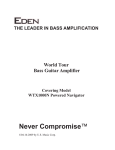Download Eden WT-405 Time Traveler Operating instructions
Transcript
Time Traveler Bass Guitar Amplifier Covering Models WT330, WT390, WT405 THE LEADER IN BASS AMPLIFICATION. ©06-14-2005 by U.S. Music Corp. Bass Guitar Amplifier WT330, WT390, WT405 OPERATION MANUAL Publishing Date 06-14-2005 FOREWORD Congratulations on the purchase of your new Eden World Tour Integrated Amplifier System. All of us at Eden are totally committed to providing you with the very best bass guitar systems in their class. Our goals are to offer you the outstanding performance quality of a top-notch, professional bass amplification system at a reasonable price point, and to make World Tour amplifiers the most musical and reliable Bass amplifiers available. This manual will cover all domestic and international versions of the Time Traveler amplifiers, including the WT330, WT390 and WT405. The WT330 delivers 200 watts RMS output @ 8 Ohms, 330 watts @ 4 Ohms and 420 watts @ 2 Ohms. The WT390 delivers 235 watts RMS output @ 8 Ohms, 390 watts @ 4 Ohms and 625 watts @ 2 Ohms. The WT405 delivers 250 watts @ 8 Ohms, 405 watts @ 4 Ohms and 650 watts @ 2 Ohms. All have +3dB of headroom and feature thermostatically controlled active cooling systems with built-in thermal safeties. You have purchased what we feel is one of the finest bass amplifiers in the world. The new pre-amplifier section, with its familiar Eden Enhance control and powerful new 3-way tone control system are coupled to a studio quality compressor. The new automatic Dynamic Booster for low and high frequencies, along with a mid shifter, tone bypass, selectable DI, selectable distortion and a gentle auto-compression circuit, allow you to achieve a wide array of sounds. This compact, rack mountable package houses modular circuits made with superior components and designed for years of troublefree service. 2 The Eden World Tour products group is the result of our quest for ultimate bass tone and maximum reliability. Your new Time Traveler Amplifier features our latest solid-state front end, using the Golden Ear chip to provide unequaled tube emulation. This chip was originally designed for use in highend recording consoles, such as the Harris and Neve units. While the cost is much higher than that of other chips, we believe the result is more than worth the cost and think you’ll agree. Your amplifier was designed, engineered and manufactured equivalent to aircraft vibration standards and housed in a one-piece aluminum case with steel top to ensure maximum reliability. The modular design allows quick repair in the field should such a need arise. The Eden line of World Tour amplifiers is the result of our research and development in combining high performance and compact size. Just as a skilled craftsman needs good quality tools that won't let him down on the job, so does a good musician. We hope you enjoy the tool we’ve created for you. Have fun; play low! Please read this manual in its entirety before operating your new amplifier. Failure to do so could result in misuse or damage. We’ve taken the time to write it, which was a lot longer than the time it will take for you to read it. Help us help you by taking a few moments to learn how to properly use your new amp. You’ll be glad you did! Please complete for your records: Date of Purchase: __________________________ Model: ___________________________________ Serial Number: _____________________________ Dealer: ___________________________________ 3 CAUTION! Your ears are your most important piece of equipment. Unfortunately, they cannot be replaced as easily as your other gear. Please take the following warning seriously. This product, when used in combination with loudspeakers and/or additional amplification may be capable of producing sound levels that could cause permanent hearing loss. DO NOT operate at high volume levels or at a level that is uncomfortable. If you experience any discomfort or ringing in the ears or suspect hearing loss, you should consult an audiologist. Thank you for your purchase of an Eden bass guitar product. This unit has been designed and constructed to give you years of trouble-free service. Please take the time to review this manual and to send in your warranty registration card. 4 FRONT PANEL FEATURES Input Jacks – Designed to accept a standard _ inch mono phone plug. For best results use a high quality shielded cable to connect your instrument to the amplifier. Both inputs are buffered and will handle standard passive, high level active, and piezo input signals. Both jacks can be used simultaneously. Mute switch – Mutes all the outputs except the Tuner Out, allowing for silent tuning. Lead singers and guitarists love this feature! The indicator lights when Mute is ON. D.I. Selector – Allows the user to send the D.I. before (PRE position) or after (POST position) the Tone Control section. Input Gain Switch – By pushing the Gain Switch in, you engage a +10db gain boost. For low gain instruments use the High Gain position. Hi Gain Indicator LED – Lights to indicate that the unit is in the high gain position. Warm Switch – This switch engages the positive half-wave tube-style warmth circuit, which is part of what the Golden Ear Chip is there for. The warmth/grit effect is increased by adding more input gain. Warm Trim – Located behind the front panel. Use a small screwdriver to adjust the level of the effect. Gain Control – Regulates the first gain stage of the preamplifier and controls the amount of signal available to the system. Clip Indicator – Flashes to indicate clipping anywhere in the system. Clipping is a Very Bad Thing and will degrade the quality of your sound. Therefore, this indicator should never be lit up. Compressor Control – This adjusts the threshold level of the compressor. The ratio is fixed at an optimum point for Bass reproduction. Compressor Indicator – Lights to indicate that the signal has crossed the threshold of the compression circuit and that compression is taking place. 5 Compressor Bypass – Turning the Compressor control OFF will disengage the compressor. Enhance Control – Called the “Magic Knob” by some, this complex control simultaneously boosts the very low bass, upper middle, and high frequencies while putting a dip in the lower middle frequencies. It is flat when set to its minimum level (fully counterclockwise). Tone Control Section These three controls and two switches allow you to boost or cut the tone at the desired frequency. The spacing allows the controls to interact smoothly and musically. From left to right, the controls and switches are: Bass – This traditional shelving tone control provides 15 dB of boost or cut at approx. 30Hz. The control is flat in the 12:00 position. Tone Bypass Control – Located between the Bass and Mid tone controls. A great tool for recording, this bypasses the tone section only and does not effect the Dynamic Boost or the compressor. Midrange Control – This covers the center portion of the sound envelope and can be critical to getting your sound right. The body of the Bass Guitar sound is in the Midrange. Mid Shift Control – Located between the Midrange and Treble tone controls. This switch shifts the Midrange control from low mid (550Hz), which is good for general playing and recording, to the high mid position (2.2KHz) for Rock and more aggressive tones. Treble – This traditional shelving-type tone control provides 15 db of boost or cut at approximately 11KHz. The control is flat at the 12: 00 position. Dynamic Boost – Immediately to the right of the Treble control you will find two switches labeled Bass and Treble. These engage the Dynamic Boost. This feature allows the extreme lows and highs to be adjusted to the ear’s relative loudness curve (Fletcher-Munson curve). This ensures the bass will sound full and solid even at very low playing levels. 6 We recommend you engage these switches at low volumes so that your sound remains consistent at any volume. At higher volume levels they aren’t needed but you may want to use them as a matter of taste. Because we strongly support Freedom of Choice, we’ve incorporated these two switches into our design. (You’re welcome.) Master Level Control – Adjusts overall system output and stage loudness. Headphone Jack – Accepts a standard _ inch stereo or mono headphone plug. It can also be used as a Master Output send to slave another amplifier. Output Limit Indicator – Lights to indicate activity of the power amplifier limiting circuit, which protects the speaker system from severe distortion. This LED indicates that the amplifier has reached its maximum output level. Mains On/Off Switch – This switch turns the system power ON or OFF. The switch illuminates to indicate the presence of AC power present in the chassis. This switch is prior to the fuse. The switch light can be on even if the fuse is blown. The light in the switch may flicker depending on local voltage conditions. This is normal and nothing to be concerned about. Speaker On/Off Switch – This switch turns off the loudspeaker output jacks allowing the user to use the headphones only for silent practice. Room mates and neighbors may really appreciate this feature, especially at three in the morning. REAR PANEL FEATURES Combination Power Cord Jack and Fuse Holder – The removable power cord is attached here. To access the fuse holder, pull the holder out of the top of the power receptacle. Your unit was shipped with a spare fuse inserted in the fuse carrier. USE ONLY THE SAME SIZE AND TYPE FOR REPLACMENT. Using a fuse with a different rating than specified is a VERY BAD THING and can cause damage to your amplifier. All models come with a holder marked (FUSE) and are factory configured for 100/120/ 230/240 only and must be adapted by a service tech for any voltage change. The standard fuse for U.S. use is a 5 Amp slow blow or time delay type. Do not use fast blow fuses. 7 Amp Outs – These consist of two _ inch jacks and an NL-4 connector (sometimes called a Speakon). The jacks are wired in parallel. The total speaker load impedance should not go below 2 ohms. On NL-4 connectors, we use +1, -1 connections. Amplifier Power Rating: WT330 200 watts RMS @ 8 Ohms 330 watts RMS @ 4 Ohms 420 watts RMS @ 2 Ohms WT390 235 watts RMS @ 8 Ohms 390 watts RMS @ 4 Ohms 625 watts RMS @ 2 Ohms WT405 250 Watts RMS @ 8 Ohms 405 Watts RMS @ 4 Ohms 655 Watts RMS @ 2 Ohms All models have +3dB of headroom. This means that the maximum output is twice the RMS rating. Mono Pre-Tone Effects Send/Return – These standard _ inch jacks allow you to send and receive your signal to and from external devices. The effects loop is positioned post (behind) the compressor and before the Enhance control and the tone section. This loop is at line level; do not use instrument level effects in this loop as they tend to be overloaded by the higher signal level which can cause distortion. Recording Out – This fully balanced XLR output allows you to send a preor post-EQ signal to a recording or sound reinforcement mixing console. We use Pin 2 hot configuration. Adjusting the Master Volume control will not affect this send. This output is designed to use with phantom powered systems. However, it never hurts to turn off the phantom power at the board, if possible. 8 D.I. Level – Controls the level being sent from the XLR balanced output jack. We suggest setting the control at approximately 12 o’clock initially. If the signal to the board is too hot, it’s better to engage the Input Pad on your channel of the board than to turn it down here, if at all possible. In general, it’s better (in terms of signal-to-noise ratio and dynamic presentation) to send as hot a signal as possible to the board. However, you can adjust the signal level, if necessary, so make sure your soundperson or recording engineer is aware of this capability. Ground Lift Switch – This switch lifts the ground within the balanced output system to allow you to eliminate excessive noise/ground loops when connected to external systems. Stereo Aux. Input - These standard _ inch input jacks are designed to accept the signal from an external source such as a CD or cassette player, drum machine, synth. module, etc. The signal is summed (added in) prior to the tone controls and Master Volume control. These jacks can also be used to return a studio cue signal, allowing the Time Traveler to provide you with your own headphone mix in the studio. Amplifier Break Link – These are provided to break the signal chain at the input to the amplifier. This can be used as an insert point or control point for the final amplifier. Unlike an FX (effects) Loop, this separates the pre-amp and power amp completely. This means you can do some Really Neat Things, such as using the power amp to drive a monitor or two while using the pre-amp section to drive a separate, larger power amp for your bass speakers. Of course, you can also use these jacks as a post-EQ FX Loop. Tuner Out Jack – This standard _ inch jack is designed to provide a pregain signal for connection to a tuner. It can also be used to provide pre-tone signal to other devices such as a direct box or console. The signal is 2X input, enough to provide adequate signal to virtually every tuner on the market. Cooling System – Your amplifier features a thermostatically controlled fan, which will switch on when the internal temperature reaches 130 degrees F. In low volume situations (into 8 Ohm loads) the fan may not come on at all. 9 The cooling system also features a high temperature thermal safety system, which will activate an AGC (Automatic Gain Control) circuit if the operating temperature goes above 190 degrees F. This circuit will automatically turn down the output of the system in the event of overheating. It will automatically reset itself to full power as soon as the unit cools down to a safe operating temperature. NOTE: the D.I. will continue to operate normally even when the amplifier is in thermal safety mode. Only the stage sound will be lost. IMPORTANT NOTE: Excessive heat is a Very Bad Thing and can result in severe damage to your amplifier. DO NOT bypass or disconnect any part of your thermal safety system. Doing so will immediately void your warranty! SECOND REALLY IMPORTANT NOTE: Do NOT remove the rubber feet from the bottom of your amp unless you are mounting it in a rack. There is a vent underneath the amp; covering this vent will decrease the effectiveness of the cooling system and may cause damage to your amplifier. Don’t say we didn’t warn you! OPERATING INSTRUCTIONS Mechanical and Thermal Issues – During operation, your amplifier should always be placed away from sources of moisture or heat. Care should be taken not to obstruct the ventilation holes on the bottom and sides of the unit. In the event of thermal shutdown, you should eliminate the cause of the thermal problem (poor ventilation, speaker loads lower than 2 ohms) immediately. The supplied rack ears can be used to install your amplifier in a conventional equipment rack for protection during transportation. Electrical Connection – The Time Traveler requires at least 10 Amps of correctly wired alternating current for proper operation. Providing less than 10 Amps of power may result in poor amplifier performance and bad tone, so it’s probably not a good idea to plug all of your band’s gear into a single wall outlet. 10 Connections – All instrument-level input connections (everything but the speakers) should be made with high quality shielded cables. The use of speaker cables for input connections will result in excess noise. Speaker connections should be made with high quality 16 gauge or heavier unshielded speaker cables. We recommend 10 or 12 gauge cables. The use of shielded line or instrument cables for speaker connections can damage your amplifier. The speaker cable should be as short as possible. INITIAL SET UP As bassists, each of us has in our head a concept of our perfect sound. Eden amplifiers are designed to help you easily achieve the sound you hear inside you. However, it’s a multi-step process as explained below. In order to ensure the ultimate in tone, it’s important to follow the procedure outlined below. Don’t skip steps; don’t jump around. Yes, this may take a minute or two, but the work is well worth it. Once they’ve done it a few times, most users can do it time and again in about a minute. IMPORTANT NOTE: Before you plug in your unit for the first time, please do the following things. First, turn the power switch to the OFF position. Check the back of your unit for the correct voltage notation for your county of operation. Once you’ve ensured correct voltage, set the Master Volume control to minimum (fully counter-clockwise). Set the tone controls to the center position (12:00 or 0). Turn the Enhance control to the minimum position. Set the Input Gain control to the minimum (fully counter-clockwise). Set the Compressor to the OFF position (fully counter-clockwise). On the front of the unit, set the Speaker switch in the ON position. Make sure the Dynamic Boost switches are OFF. This will set your amplifier up flat and with the Compressor disengaged. Next, plug in the power cord to the AC inlet on the back of the unit. Use only a safe grounded receptacle for proper operation at the correct voltage for your country. Double check to make certain your amplifier is set for the correct voltage in your country. 11 Turn On – Once you’ve completed the steps above, you can plug in your bass and turn on the unit (plug it in first, ok?) and let’s get started. We recommend turning your system on with the Master Volume control set to its minimum position. This will prevent any unexpected signal from being sent to your speakers. Setting Your Level – Remember, begin with the Input Gain, Enhance, Compressor and Master Volume completely OFF – fully counter-clockwise. All EQ should be set flat, that is, at 12:00 – straight up. While playing your lowest note (or loudest), slowly turn the Input Gain up until the Clip light begins to blink with regularity. If you go past 2 or 3 o’clock, engage the Gain Switch to better match the gain of your instrument to the amplifier. If you have disengaged the Compressor as we suggested, the Clip light will barely blink on your loudest notes when you reach clipping in the Input stage. We recommend you decrease gain one or two clicks to ensure there is no clipping in the system. By the way, this is David’s favorite way to set level, even if you intend to use compression. Once you have properly set your Input Gain, turn the Master Volume up to a comfortable listening level and proceed with the rest of the setup process. Setting the Compressor - If you want to use compression, engage it now by turning up the Compressor Threshold control. The compressor light will blink when your gain goes above the compression threshold. This will generally show up more on the lower notes, or when you employ Slapping. (A properly compressed Slap sound is very cool, indeed.) 12 SETTING YOUR EQ The frequencies that you’ll need to boost or cut are dependent upon your instrument, playing style, speaker cabinets, and venue. Extreme settings of boost or cut are unlikely to be necessary or helpful. We are frequently asked to provide suggested settings for various styles of play. We have discovered though, that most of our endorsers tend to set their EQ generally flat, using varying amounts of the Enhance Control to achieve their sound. In fact, a number of our recording artists tell us that their standard recording set-up is to have the Enhance set at approximately 9 or 10 O’clock and the tone controls set flat. They then send a post-EQ D.I. to the board. We encourage you to experiment with different settings to obtain the sound you desire. We have included some EQ panel diagrams at the back of this manual to help you record your settings. Enhance – Once you’ve set your gain, you can move on to setting your EQ, beginning with the Enhance control, or Magic Knob, as some call it. The Enhance circuitry adds very low bass, upper mids and highs while scooping out a bit of low middle. The more Enhance effect you dial in, the greater the boost (and cut). As with all of our EQ controls, a little goes a long way. Slowly bring the Enhance control up while playing. If you turn it up close to maximum on the dial and still don’t have your sound, stop there. Return the Enhance to OFF or leave it at no more than 12:00 and work with the EQ section. Using the EQ Controls – Before you begin to twiddle knobs, let’s talk about a few things. Excessive boosting of one or more EQ frequencies may cause an overload in the EQ section. If this happens, the Clip light will engage. This is a Very Bad Thing and needs to be corrected immediately. If EQ clipping occurs, you can either decrease the boost or decrease the Input Gain. Remember, too, that our EQ controls are active, and are meant to turn both ways – not just UP! This means that you can enhance a certain frequency spectrum either by boosting that frequency or by cutting the adjacent frequencies. This latter method has the advantage of maximizing potential headroom. If possible, step well forward of your rig to get a better idea of how you will sound in the room. You may be surprised at how different you sound once you step away from the speakers. 13 NOTE: Many players rely on the Enhance Control (and perhaps a little Midrange Massage) to get their sound. This method leaves the Bass and Treble controls available to dial in to a particularly difficult room. Just something to keep in mind, ok? Setting Bass and Treble – OK, now it’s time to set the EQ, beginning with the Bass and Treble controls. These controls cover a fairly broad frequency spectrum and a little goes a long way. Adjust these controls up or down as needed. We suggest playing a few notes in various areas of the neck so you can hear what your adjustments have done across the fretboard. Setting the Midrange – Adjusting the Midrange control will bring you either more up-front in the mix or more in the background. As mentioned earlier, you can choose between center frequencies for the Midrange control – either 550Hz or 2.2KHz. The low position (550Hz) is good for general playing and recording. It’s also good for dialing in a good Fretless Bass tone. The high position (2.2KHz) is good for getting a more aggressive Rock tone. We suggest you start in the low position. While playing, boost and cut the Midrange so you can hear how it affects your tone. Remember to play in all ranges, not just on the first few frets. Once you have an idea of the tonal possibilities, switch to the High position and do the same thing. This will give you a better idea of what this control can do for your sound and you can then dial in what you want more effectively. NOTE: Don’t forget that you can disengage the entire tone control system by pushing the EQ Bypass switch. This is Really Neat Thing that many users like to use when recording. ANOTHER NOTE: If you plan on using the Warmth circuit to get some extra grit in your sound, you may want to wait a minute before adjusting the Midrange. So let’s talk about the Warm Switch now. 14 Warm Switch – This works with the Golden Ear Chip we told you about earlier. If you want to introduce some extra tube-style warmth (and just a touch of grit) into your sound, this is button to push. Once this button is engaged, your Input Gain determines how much warmth is dialed in. Keep in mind that increasing the gain level will affect how the compressor operates. That’s where the Warm Trim Pot comes in. Warm Trim Pot – Look closely at the front of your amplifier. See that tiny little hole below and to the left of the Input Gain? Inside that hole is a small set screw that allows you to adjust the amount of warmth added to your sound. Turn it to the left and you decrease the warmth level. Turn it to the right and you increase it. Some people want lots of grit; other people want just a touch of extra tube warmth. By adjusting the Input Gain and this set screw, you can get the right amount of both distortion and compression for your sound. It might take a minute or two the first time, but it’s well worth the effort. Engage the Dynamic Boost – As mentioned earlier, this effect is based on the Fletcher-Munson curve and ensures that the bass is full and the highs are crisp, even at the lowest volume settings. As volume increases, the effect is reduced, resulting in very consistent tone regardless of volume level. We suggest you spend some time experimenting with this Really Neat Feature. We believe that you’ll think it’s Really Neat, too. Final Settings – If you haven’t adjusted the Midrange yet, now is the time to do it. Boosting or cutting the mids may change how much warmth and grit you dial in, so be prepared to make adjustments there as well. A FEW TECHNICAL THINGS TO REMEMBER Clipping = Bad – Keep an eye on the EQ Clip light. If it blinks, either reduce Input Gain or cut back on one or more EQ ranges. As we said earlier, Clipping in the preamp section is a Very Bad Thing and is to be avoided at all times. If you find yourself running out of amplifier headroom, cut a little in the lower frequencies, which require the most power from your amp. You’ll know this is happening if you see the Limit light flashing. As long as the light is just blinking, you’re fine. But, if it’s on more than it’s off, you might want to back off a bit. 15 Frequency Oddities – Two areas are a frequent source of frustration for bassists trying to achieve their sound: frequency masking and frequency enhancement. Frequency masking occurs when other instruments (particularly cymbals and electric guitars) obscure the important upper harmonic content of your sound. As a result, you find that the EQ settings that were so perfect at home lack definition in a live setting. On the other hand, the stage settings that worked so well sound harsh and/or thin in the absence of other instruments. Frequency enhancement results from cabinet placement and room acoustics. A cabinet placed on the floor will have the lower frequencies boosted by about 3 db. Placement against a wall adds another 3 db. A corner adds 3 db more. Consequently you may find a surprising boominess to your sound. Certain qualities in the room itself can also enhance the lower frequencies, further contributing to this problem. Frequently this effect is more noticeable in the audience than it is on stage. Compensating for it may result in a stage sound that may seem a little thin. However the sound is actually quite full out in front. NOTE; Remember, you can’t equalize out major physical room anomalies. If things sound really weird where you are, try moving you rig a few feet and see if that helps. This may be particularly helpful on saggy stages that bounce like a drum head. (The propellerhead term for this is “diaphragmatic.” So says David. – LB) YOU’RE DONE. GO PLAY. There you have it: a quick and easy process to help you get the perfect tone from your Eden amplifier. As previously mentioned, it make take a few extra minutes the first few times you go through this, especially if you take the time to experiment with all the knobs and switches, which we highly recommend. We are confident that the time you spend getting to know your new friend is an important investment, one that will pay off immeasurably in Great Bass Tone. And, after all, that’s why you bought an Eden, right? 16 OTHER CONSIDERATIONS Suggested Speaker Systems – Your speaker system should be chosen to accommodate the characteristics of your amplifier and your predominant application. If you will only be using one cabinet, a 4 Ohm model will draw the most current from your amplifier. If you will generally be using two cabinets, they should both be 8 Ohm models so their combined impedance will be 4 ohms. If you are uncertain about your future needs, always go with the 8 Ohm speaker option so that you can add another speaker later if you need to. In general, adding more speakers will give you a greater volume increase than adding a few more watts. We have designed our amplifiers to operate safely at 2 Ohms only because everyone else is doing it and some users expect it. However, we much prefer operating at 8 or 4 Ohms because of the markedly improved quality of tone and dynamic response. But if you really want to, you can operate your Time Traveler at 2 Ohms without worry. Headphone Jack as a Line Driver – On some occasions (such as highvolume or outdoor situations) it may be desirable to use the Time Traveler along with an additional power amplifier and added cabinets. A standard shielded instrument cable may be used to connect from the headphone jack of the unit to an unbalanced input of a standard power amplifier. This will provide a signal that is post-EQ and after the Master Volume control, allowing the entire system to be controlled from the Time Traveler. This way, you only have to adjust one set of knobs. This is a Really Neat Thing, huh? Using the Time Traveler Without Speakers -This amplifier is designed to be used safely with headphones only, without the loud speaker plugged in. No harm will result from using the amplifier in this fashion. This allows the use of the unit for practice with headphones and as a preamplifier with other amplifiers. Like we said earlier, neighbors and room mates really love this, which qualifies it as another Really Neat Thing. 17 MAINTENANCE Your Eden amplifier has been designed to require minimal routine maintenance. Attention to the following areas will ensure optimum performance of your amplifier. We’re serious. Don’t blow this off, OK? Contact Point Cleaning – One of the weakest links in most bass amplification systems are the solderless connection points where instruments, speaker cabinets, effects, and other devices are connected to the amplifier. (The most vulnerable of these types of connection is the jack on your instrument). In addition to contamination from airborne pollutants, these points are frequently assaulted by connectors that have picked up debris from dirty stages, cases, etc. This contamination can result in poor contact as well as poor tone, and we all know that bad tone is a Very Bad Thing. These points should be cleaned regularly with a cotton swab soaked in denatured alcohol or a commercially available de-oxidant. Frequent cleaning of the plugs on your cords is also recommended. Dust Removal – You should periodically inspect the ventilation openings on the top and sides of the unit to ensure that they have not become blocked by accumulated dust. Vacuum the openings to remove any dust buildup. Dust bunnies are definitely not cool. The Magic Smoke – Few people realize just how much magic goes into creating Great Bass Tone. It isn’t something you normally need worry about. Just have fun and leave all that to us. However – and this is very important – if you ever release the Magic Smoke from your amplifier this is indeed a Very Bad Thing, perhaps the worst thing you can do. If you see any smoke (Magic or otherwise) coming out of your amplifier, immediately turn it off and seek the services of a qualified magician…uhm, we mean…technician. DO NOT continue to use the amplifier in this condition. Learn More – If you’d like to learn more about your amplifier (or about our company and its activities), we invite you to visit our website – www.edenelectronics.com. There you’ll find articles to help you better understand our products and the technical stuff some people find so interesting. You’ll also find our FAQ (Frequently Asked Questions) file, which is updated regularly. 18 While you’re there, check out our on-line forum. There you can meet hundreds of other Edenites who’ll be glad to help you with any questions you may have about our gear. Not to brag too much, but we think our forum is a Really Neat Thing, filled with Really Neat People. We’re pretty sure you’ll think so, too. Service – In the event of amplifier malfunction, or questions about your unit’s operating features that aren’t answered in this manual or on our website, you should contact your Dealer. Once you and your dealer have determined it’s definitely a malfunction (and not an operator error) you must call our Customer Service Department and obtain a Return Merchandise Authorization (RMA). We WILL NOT accept any gear sent without an RMA, so save the time and money by calling first, ok? Please call the USM Customer Service Dept. at: 1-800-USSOUND (1-800-877-6863) When you hear the voice prompt, Press 1 on your phone’s keypad. Please ship Authorized Returns for service to: Eden Electronics P.O. Box 338 115 2nd Street Montrose, Minnesota 55363 Email [email protected] Website http://www.eden-electronics.com Eden Electronics C/O U.S. Music Corp. 444 E. Courtland Rd. Mundelein, IL 60060 (847) 949-0444 (847) 949-8444(fax) Eden Never Compromise Note for those who care: This manual was written by David (Eden) Nordschow, Eden’s Chief Propellerhead & Master of All Things Technical, and Lane Baldwin, Eden’s Special Projects Coordinator (Many Other Functions). Any grammar errors are David and Lane’s fault, as are the attempts at humor. Please don’t blame anyone else for any weirdness, as we were warned several times. Really. 19 My Favorite Settings Setting 1____________________________________________________ Setting 2____________________________________________________ Setting 3____________________________________________________ Setting 4____________________________________________________ 20




















